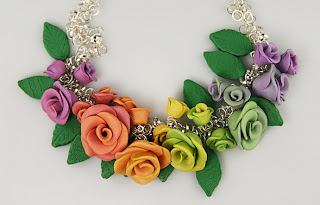 I'm going to be the featured artist at the Westerly Arts Gallery for the month of April, and I've been working on pieces for the show. I'm particularly pleased with three necklaces I made, all using different Skinner blend rainbows. One piece uses the lei petals I made based on a rainbow blend developed in class with Lindley Haunani. I strung the beads tightly to get the ruffled effect, then finished the strand with light green new jade, amethyst, and darker green jade beads.
I'm going to be the featured artist at the Westerly Arts Gallery for the month of April, and I've been working on pieces for the show. I'm particularly pleased with three necklaces I made, all using different Skinner blend rainbows. One piece uses the lei petals I made based on a rainbow blend developed in class with Lindley Haunani. I strung the beads tightly to get the ruffled effect, then finished the strand with light green new jade, amethyst, and darker green jade beads.
Another necklace is similar to one I've made in the past. This necklace takes forever to assemble, since each flowerette has it's own crystal on a head pin and is then attached to the chain. I've only made 3 of these, probably because they take so long to make. You can see the difference in the rainbow palette between the lei necklace on the hand display, and the blossom necklace below.



















